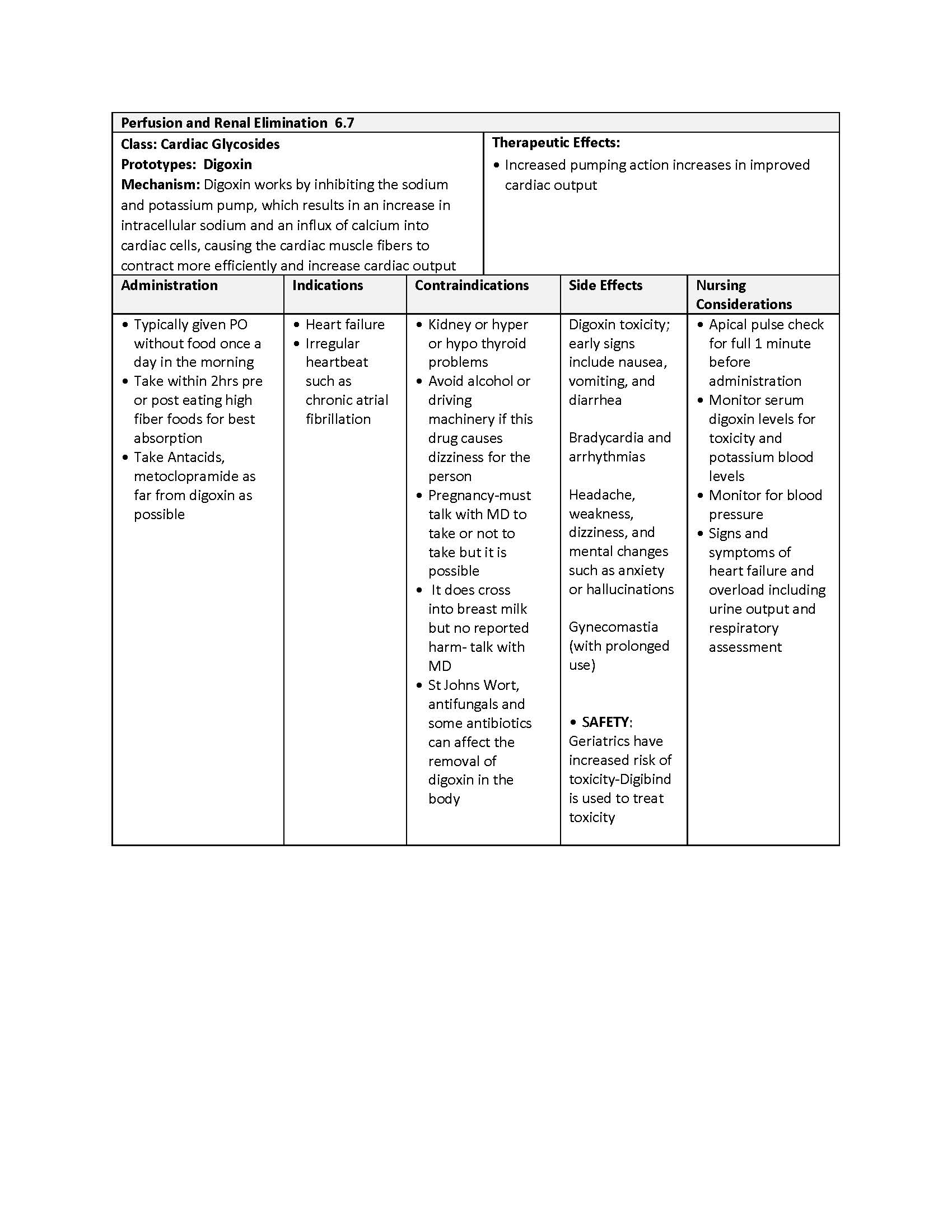Perfusion and Renal Elimination
6.7 Cardiac Glycosides
Open Resources for Nursing (Open RN)
Cardiac Glycosides
Digoxin
Digoxin is a cardiac glycoside medication that has been used for centuries to treat heart failure. Currently it is the only positive inotropic drug we see in practice. It has three effects on heart muscle: positive inotropic action (increases contractility, stroke volume and, thus, cardiac output), negative chronotropic action (decreases heart rate), and negative dromotropic action (decrease conduction of cardiac cells). The inotropic effect of digoxin supports improving the heart’s ability to pump with more strength, but it is important to understand that being on digoxin too long can actually cause more heart failure. Imagine that you have an elastic hairband; eventually, as you stretch it repeatedly over time, it either loses its elasticity or it breaks. The heart can only take so much force of contraction for so long before the stretch becomes exacerbated. Digoxin, although ground breaking for heart failure, should really be saved for use closer to end stage heart failure to support the heart in the final stages.[1]
Mechanism of Action
Digoxin works by inhibiting the sodium and potassium pump, which results in an increase in intracellular sodium and an influx of calcium into cardiac cells, causing the cardiac muscle fibers to contract more efficiently and increase cardiac output.[2]
Indications for Use
This medication is used as second-line treatment for clients who have heart failure or atrial fibrillation. Due to the risk for digoxin toxicity, the clinical use of digoxin has decreased and alternative, safer medications are being used. Also, remember that digoxin has an impact on the contractility of a heart, so this must be considered by the prescribing professionals.
Nursing Considerations Across the Lifespan
Apical pulse should be taken for a full minute before administration of this medication. If the apical pulse is less than 60, the dose should be withheld and the prescribing provider notified.
Serum digoxin levels should be monitored, with a normal therapeutic range from 0.8 to 2 ng/mL.
Serum potassium levels should also be closely monitored for clients on digoxin because hypokalemia increases the effect of digoxin and can result in digoxin toxicity. Normal potassium level is 3.5 to 5.0 mEq/L, and a result less than 3.5 should be immediately reported to the provider.
Nurses should closely monitor signs of digoxin toxicity. Geriatric clients have an increased risk for developing digoxin toxicity. Digibind is used to treat digoxin toxicity.
Adverse/Side Effects
Overdose or accumulation of digoxin causes digoxin toxicity. Signs and symptoms of digoxin toxicity are bradycardia (heart rate less than 60), nausea, vomiting, visual changes (halos), and arrhythmias. Cardiotoxicity is a serious adverse effect with ventricular dysrhythmias. Toxicity of this medication typically occurs at greater than 2 ng/mL, but some clients may have signs and symptoms at lower levels. Pediatric clients typically present with bradycardia or arrhythmias if toxicity is occurring.
Decreased renal function, hypokalemia, hypercalcemia, and hypomagnesemia may increase risk for digoxin toxicity.
Common side effects include GI symptoms, headache, weakness, dizziness, anxiety, depression, delirium, and hallucination.[3]
Client Teaching & Education
The client should be instructed to follow the prescribed dosing regimen and take medications at the same time each day. The client should be cautious not to double up on medication doses. Additionally, the client should consult the healthcare provider for follow-up instruction if two or more doses of medication are missed.
Clients should receive education regarding pulse rate monitoring and report any pulse rate less than 60. If the client experiences signs of digoxin toxicity, this should be reported to the provider immediately. The medication should be stored in its original container and care should be taken not to mix the medication with other medications.[4]
Now let’s take a closer look at the medication card for digoxin in Table 6.7.[5]
Table 6.7 Digoxin Medication Card

Clinical Reasoning and Decision-Making Activities 6.7a

- Why should a nurse assess the apical pulse for 1 full minute before administering digoxin?
- How does a nurse evaluate whether digoxin is effective?
- Why must the nurse monitor serum potassium levels as well as digoxin levels?
- A nurse enters a patient’s room and the patient complains “My vision seems strange and I feel nauseated.” What is the nurse’s next best action?
Note: Answers these questions can be found in the “Answer Key” sections at the end of the book.
Digibind
Digibind is used to treat digoxin toxicity.
Mechanism of Action
Digibind binds to digoxin molecules, reducing free digoxin.
Indications for Use
This medication is the antidote for digoxin. Digibind is administered when a patient is experiencing life-threatening digoxin toxicity.
Nursing Considerations Across the Lifespan
There are no contraindications when using digibind.
Adverse/Side Effects
The most common effects a client may experience are worsening heart failure or atrial fibrillation, and hypokalemia.[6]
Client Teaching & Education
The client should report any signs of worsening heart failure, atrial fibrillation, or hypokalemia immediately to the healthcare provider.[7]
Media Attributions
- Digoxin
- McCuistion, L., Vuljoin-DiMaggio, K., Winton, M, & Yeager, J. (2018). Pharmacology: A patient-centered nursing process approach. pp. 443-454. Elsevier. ↵
- McCuistion, L., Vuljoin-DiMaggio, K., Winton, M, & Yeager, J. (2018). Pharmacology: A patient-centered nursing process approach. pp. 443-454. Elsevier. ↵
- This work is a derivative of Daily Med by U.S. National Library of Medicine in the public domain. ↵
- uCentral from Unbound Medicine. https://www.unboundmedicine.com/ucentral ↵
- This work is a derivative of Daily Med by U.S. National Library of Medicine in the public domain. ↵
- This work is a derivative of Daily Med by U.S. National Library of Medicine in the public domain. ↵
- uCentral from Unbound Medicine. https://www.unboundmedicine.com/ucentral ↵

